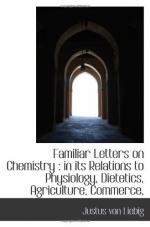Inter-penetration of elements in the production of a chemical compound, supposes two distinct bodies, A and B, to occupy one and the same space at the same time. If this were so, different properties could not consist with an equal and identical composition.
That hypothesis, however, has shared the fate of innumerable imaginative explanations of natural phenomena, in which our predecessors indulged. They have now no advocate. The force of truth, dependent upon observation, is irresistible. A great many substances have been discovered amongst organic bodies, composed of the same elements in the same relative proportions, and yet exhibiting physical and chemical properties perfectly distinct one from another. To such substances the term Isomeric (from 1/ao1/ equal and aei1/o1/ part) is applied. A great class of bodies, known as the volatile oils, oil of turpentine, essence of lemons, oil of balsam of copaiba, oil of rosemary, oil of juniper, and many others, differing widely from each other in their odour, in their medicinal effects, in their boiling point, in their specific gravity, &c., are exactly identical in composition,—they contain the same elements, carbon and hydrogen, in the same proportions.
How admirably simple does the chemistry of organic nature present itself to us from this point of view! An extraordinary variety of compound bodies produced with equal weights of two elements! and how wide their dissimilarity! The crystallised part of the oil of roses, the delicious fragrance of which is so well known, a solid at ordinary temperatures, although readily volatile, is a compound body containing exactly the same elements, and in the same proportions, as the gas we employ for lighting our streets; and, in short, the same elements, in the same relative quantities, are found in a dozen other compounds, all differing essentially in their physical and chemical properties.
These remarkable truths, so highly important in their applications, were not received and admitted as sufficiently established, without abundant proofs. Many examples have long been known where the analysis of two different bodies gave the same composition; but such cases were regarded as doubtful: at any rate, they were isolated observations, homeless in the realms of science: until, at length, examples were discovered of two or more bodies whose absolute identity of composition, with totally distinct properties, could be demonstrated in a more obvious and conclusive manner than by mere analysis; that is, they can be converted and reconverted into each other without addition and without subtraction.




